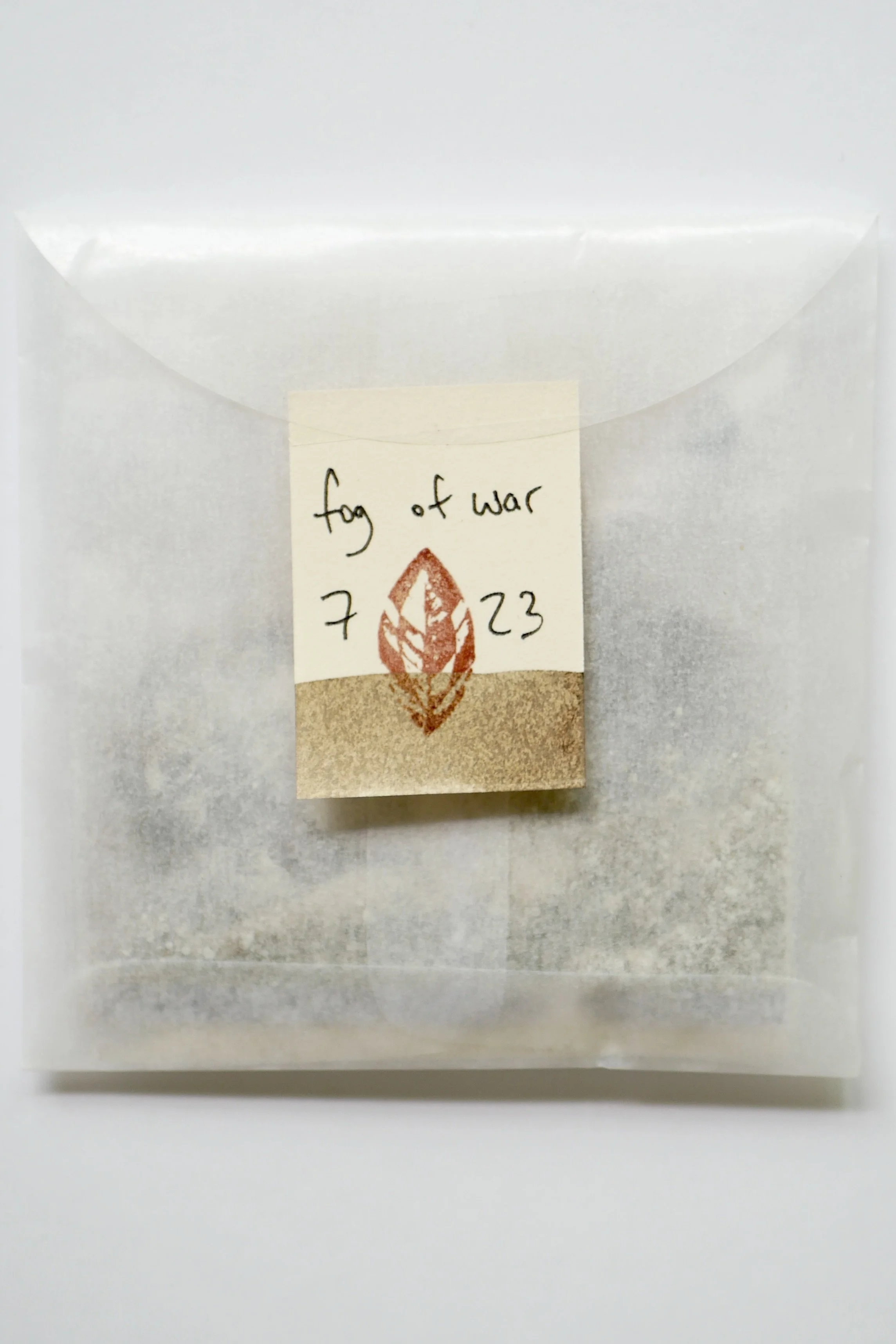fog of war : july ’23
‘Fog of War’ is a kit for making gallo-tannic ink, a special, three-way collaborative pigment with three distinct components: powdered oak galls, stone-fruit gum (mixed with some gum arabic), and iron sulphate. The oak galls were gathered this spring by artist / Wild Pigment Project founding director Tilke Elkins on unceded Cheffin Kalapuya lands (colonially known as Eugene, Oregon). Many were found on the ground, the gall wasp larvae who formed them long departed the summer before. The stone fruit was gathered from a peach tree in textile artist Deborah Gorr’s back yard, and the quantity was not quite enough, so has been mixed with a bit of commercial food-grade gum arabic (sourced most likely from acacia trees in Kenya!), purchased at a health food store.
The iron sulphate comes from now four-time Ground Bright contributor, Thomas Little. Thomas produced the iron sulphate by dissolving Russian bayonets and WWII era Smith and Wesson revolvers in sulphuric acid, resulting in a pale bluish powder that catalyzes the gallo-tannic alchemy.
Thomas named this pigment ‘Fog of War,’ as an expression of the current relationship between guns and the planet, in these times of war: the domestic war enacted through gun violence in the U.S.. The violence done not only to people but to all beings — forests, flowers, bear, spiders — in the Ukraine and everywhere war is waged. The forests that burn as a result of climate disaster, brought about by a different kind of war. The psychological violence perpetuated by the ubiquity of guns the world over.
contributor: Thomas Little
Thomas is an amateur ink historian who explores mystic and scientific concepts through the lens of ink and our relationship to mark-making. He gathers threads from alchemical imagery, chemical phenomena, and mystic observations, and incorporates them into a holistic synthesis theory of art-science-magic. The natural world informs his work with ink in not only the materials used, but the relationships expressed between plant, animal, and elements. He has formulated inks for people using some herbal requests and symbolic iron objects. He is currently developing a primary palette with iron pigments derived from gun parts, and collaborating with a slime mold, Physarum polycephalum. He is available to make inks and devotional-art-objects on request, and sells his ‘Writing Ink Made From Guns’ at retail locations in 15 states (see his Instagram account for details). He has lived many places, but always dwells near dark water, and is in the process of putting together a mobile ink lab. He can be reached through his Instagram account, @a.rural.pen, or by email, at thomas.little.films@gmail.com.
contributor: Tilke Elkins
Tilke Elkins is an artist, writer, and curator focused on site-specific/responsive painting and social practice art. Tilke has worked with mineral and botanical pigments since 2007, and is the founding director of Wild Pigment Project. In 2022, her work was exhibited at form & concept gallery in O’Ga P’Ogeh Owingeh (colonially known as Santa Fe, NM) along with a Wild Pigment Project group exhibition she curated. A version of the group show will be on view from now until September 16th at the NMSU Art Museum. She is also part of a group show, Feeding the Unseen: Remediations of Earth, curated by Heidi Gustafson and Devon Deimler at the Philosophical Research Institute in L.A. which runs through July 30th. Ground Bright is featured in the summer issue of American Craft Magazine, in a piece called Origin Stories, by Shannon Stratton, and an interview in the American Craft blog, The Queue. wildpigmentproject.org / tilkeelkins.com
contributor: Debora Gorr
Deb Gorr is a fiber and dye artist who experiments with many different plants — in her garden in the Pacific Northwest and beyond — and nurtures people, plants, and cats. Read about her current pigment adventures at https://beecreative.typepad.com.
Image from Thomas Little’s Instagram feed @a.rural.pen
Image courtesy of Noel Guetti.
Image from Deborah Gorr’s Instagram.
Photo from the Lead to Life website.
22% donation recipient : Lead to Life
Lead to Life transforms weapons into shovels for tree planting ceremonies at sites that have been impacted by violence or carry spiritual significance across Atlanta (occupied lands of the Cherokee and Creek people) and Oakland (occupied lands of the Ohlone people.) Inspired by Mexican artist Pedro Reyes and an ancient lineage of Swords to Plowshares creators, they choose to locate their alchemy and cultural healing work in the US (occupied Turtle Island). Their disarmament process collects both weapons donated from the public and weapons housed in police departments that have been rendered dormant and disposable post-investigation. In partnership with local artists and metal-smiths, the weapons are transformed into shovels and tools.The shovels are then used in ceremonial plantings of culturally significant sacred tree species. These ceremonies offer a physically regenerative space for communities to memorialize loved ones, and lands, lost to violence. Lead To Life is led by black and queer artists, including bronte velez, Jazmín Calderón Torres, Stormy Saint-Val, and Liz Kennedy. The collective uses participatory ceremony, prayer, dream work and other processes to ‘decompose’ white supremacy and the nightmares of colonization. To donate directly to Lead to Life, please go to www.leadtolife.org.






